Analysis on the Vulnerability of a Tunnel Entrance under Internal Explosion
Abstract
1. Introduction
2. Validation of the FE Model
2.1. Field Blast Test and Static Test
2.2. Development of the FE Model
2.2.1. Spatial Discretization and Modeling Process
2.2.2. Material Model
Concrete and Rebar
Soil Layer
Air and TNT
2.3. Validation
2.3.1. Reflected Overpressure
2.3.2. Damage Pattern
2.3.3. Residual Bearing Capacity
3. Prototype of the Tunnel Entrance under Internal Explosion
3.1. FE Model
3.2. Blast Scenarios
3.3. Dynamic Responses of the Prototype of the Tunnel Entrance
4. Vulnerability Analysis of the Tunnel Entrance
4.1. Analysis of Uncertain Issues
4.2. Damage Criterion
4.3. Analysis of the FE Simulation Results
4.4. Vulnerability Analysis of the Tunnel Entrance under Internal Explosion
5. Conclusions
- (1)
- When the tunnel entrance was under the action of contact explosion, a punching failure zone appeared at the location of the detonation point, and a large number of cracks radially developed around the crater, indicating that the tunnel entrance had suffered local damage. When the detonation point was in the center of the tunnel, the tunnel entrance exhibited global damage. Under the same TNT charge weight, the residual bearing capacity of the tunnel entrance after contact explosion at the tunnel crown was the lowest among all the blast scenarios. It can be concluded that damage occurring at the tunnel crown would significantly reduce the bearing capacity and stiffness of the tunnel entrance.
- (2)
- The numerical results of the finite element (FE) model were in good agreement with the actual measurements from the blast and static loading tests in terms of reflected overpressure, damage pattern and residual bearing capacity. The validated FE model was able to precisely predict the damage mode and residual bearing capacity of the post blast tunnel entrance.
- (3)
- For the central noncontact explosion scenario, when the charge weight (W) was less than 454 kg, the tunnel entrance suffered global damage, and its corresponding residual bearing capacity dropped to 63% of the maximum bearing capacity. As W increased to 1814 kg, the tunnel entrance seemed to collapse. However, when W reached 4536 kg, the tunnel entrance suffered severe damage regardless of the position of the detonation point. In addition, when the detonation point was located at the foundation slab, the degradation degree of the tunnel entrance was minimal, but the opposite result was observed when the contact explosion occurred at the tunnel crown, demonstrating that the tunnel crown was the vulnerable position for the tunnel entrance.
- (4)
- When the charge weight (W) was in the range of 0–100 kg, the probability of damage to the tunnel entrance increased rapidly. As the charge weight increased past 300 kg, the tunnel entrance’s probability of slight damage reached 1.0. When W varied from 200 to 1000 kg, the damage to the tunnel entrance shifted from moderate to severe. However, the tunnel entrance’s probability of complete damage was less than 10% when the TNT charge weight did not exceed 1000 kg. The established vulnerability diagram can be used for probabilistic assessment of the damage level in tunnel entrances subjected to various charge weights or detonation points.
- (5)
- The recommendation for the blast-resistant design of the tunnel in this paper is that the tunnel arch should be the most emphasized part in the reinforcement for the entire structure. In addition, for daily transportation, the threshold value of the TNT equivalent (Wt) of hazardous articles for carrying is 100 kg. When Wt is less than 100 kg, the vehicles can be permitted to transport. When Wt exceeds 100 kg, it is recommended for vehicles to pass through the tunnel in batches. The accumulation of Wt up to 800 kg in the tunnel is strictly prohibited.
Author Contributions
Funding
Institutional Review Board Statement
Informed Consent Statement
Data Availability Statement
Acknowledgments
Conflicts of Interest
References
- Ezell, B.; Bennett, S.; Winterfeldt, D.; Sokolowski, J.; Collins, A. Probabilistic risk analysis and terrorism risk. Risk Anal. Int. J. 2010, 30, 575–589. [Google Scholar] [CrossRef] [PubMed]
- Li, Z.; Li, X.; Dong, C.; Guo, F.; Zhang, F.; Zhang, Q. Quantitative Analysis of Global Terrorist Attacks Based on the Global Terrorism Database. Sustainability 2021, 13, 7598. [Google Scholar] [CrossRef]
- Ma, X.; Kong, D.; Shi, Y. Measurement and Analysis of Shock Wave Pressure in Moving Charge and Stationary Charge Explosions. Sensors 2022, 22, 6582. [Google Scholar] [CrossRef]
- Ma, G.; Hao, H.; Zhou, Y. Modeling of wave propagation induced by underground explosion. Comput. Geotech. 1998, 22, 283–303. [Google Scholar] [CrossRef]
- Zhao, C.; Tang, Z.; Wang, P.; Feng, J.; Zhou, J.; Kong, X.; Geng, H.; Jin, F.; Fan, H. Blast responses of shallow-buried prefabricated modular concrete tunnels reinforced by BFRP-steel bars. Undergr. Space 2022, 7, 184–198. [Google Scholar] [CrossRef]
- Zyskowski, A.; Sochet, I.; Mavrot, G.; Bailly, P.; Renard, J. Study of the explosion process in a small scale experiment-structural loading. J. Loss. Prevent. Proc. 2004, 17, 291–299. [Google Scholar] [CrossRef]
- Wu, C.; Lu, Y.; Hao, H. Numerical prediction of blast-induced stress wave from large-scale underground explosion. Int. J. Numer. Anal. Met. 2004, 28, 93–109. [Google Scholar] [CrossRef]
- Smith, P.; Mays, G.; Rose, T.; Teo, K.; Roberts, B. Small scale models of complex geometry for blast overpressure assessment. Int. J. Impact. Eng. 1992, 12, 345–360. [Google Scholar] [CrossRef]
- Feldgun, V.; Kochetkov, A.; Karinski, Y.; Yankelevsky, D. Internal blast loading in a buried lined tunnel. Int. J. Impact. Eng. 2008, 35, 172–183. [Google Scholar] [CrossRef]
- Rigas, F.; Sklavounos, S. Experimentally validated 3-D simulation of shock waves generated by dense explosives in confined complex geometries. J. Hazard. Mater. 2005, 121, 23–30. [Google Scholar] [CrossRef]
- Tiwari, R.; Chakraborty, T.; Matsagar, V. Analysis of curved tunnels in soil subjected to internal blast loading. Acta Geotech. 2020, 15, 509–528. [Google Scholar] [CrossRef]
- Meng, Q.; Wu, C.; Li, J.; Wu, P.; Xu, S.; Wang, Z. A study of pressure characteristics of methane explosion in a 20 m buried tunnel and influence on structural behaviour of concrete elements. Eng. Fail. Anal. 2021, 122, 105273. [Google Scholar] [CrossRef]
- Liu, H. Dynamic Analysis of Subway Structures Under Blast Loading. Geotech. Geol. Eng. 2009, 27, 699. [Google Scholar] [CrossRef]
- Xu, L.; Chen, L.; Fang, Q.; Dong, Y. Blast resistance of a folded arch cross-section immersed tunnel subjected to internal explosion. Tunn. Undergr. Space Technol. 2022, 125, 104521. [Google Scholar] [CrossRef]
- Yang, G.; Wang, G.; Lu, W.; Yan, P.; Chen, M. Damage assessment and mitigation measures of underwater tunnel subjected to blast loads. Tunn. Undergr. Space Technol. 2019, 94, 103131. [Google Scholar] [CrossRef]
- Choi, S.; Wang, J.; Munfakh, G.; Dwyre, E. 3D Nonlinear Blast Model Analysis for underground structures. GeoCongress 2006 Geotech. Eng. Inf. Technol. Age 2006. [Google Scholar] [CrossRef]
- Huang, Z.; Hu, Z.; Zhang, C.; Pan, Z.; Hu, J.; Chen, X. Deformation Characteristics and Damage Assessment of Prefabri-cated Frame Tunnels after Central and External Explosions. Sustainability 2022, 14, 9942. [Google Scholar] [CrossRef]
- Ellingwood, B. Mitigating Risk from Abnormal Loads and Progressive Collapse. J. Perform. Constr. Fac. 2006, 20, 315–323. [Google Scholar] [CrossRef]
- Hu, X.; Zhou, Z.; Chen, H.; Ren, Y. Seismic Fragility Analysis of Tunnels with Different Buried Depths in a Soft Soil. Sustainability 2020, 12, 892. [Google Scholar] [CrossRef]
- Argyroudis, S.; Pitilakis, K. Seismic fragility curves of shallow tunnels in alluvial deposits. Soil. Dyn. Earthq. Eng. 2012, 35, 1–12. [Google Scholar] [CrossRef]
- Federal Emergency Management Agency (FEMA). Hazus-MH 2.1-Earthquake Model User Manual; FEMA: Washington, DC, USA, 2012; 863p. [Google Scholar]
- Dowding, C.; Rozan, A. Damage to Rock Tunnels from Earthquake Shaking. J. Geotech. Geoenviron. 1978, 104, 175–191. [Google Scholar] [CrossRef]
- Le, S.; Huh, J.; Park, J. Earthquake Fragility Assessment of the Underground Tunnel Using an Efficient SSI Analysis Approach. J. Appl. Math. Phys. 2014, 2, 1073–1078. [Google Scholar] [CrossRef][Green Version]
- Avanaki, M.; Hoseini, A.; Vahdani, S.; de Santos, C.; de la Fuente, A. Seismic fragility curves for vulnerability assessment of steel fiber reinforced concrete segmental tunnel linings. Tunn. Undergr. Space Technol. 2018, 78, 259–274. [Google Scholar] [CrossRef]
- Huang, G.; Qiu, W.; Zhang, J. Modelling seismic fragility of a rock mountain tunnel based on support vector machine. Soil. Dyn. Earthq. Eng. 2017, 102, 160–171. [Google Scholar] [CrossRef]
- Chaudhary, R.; Mishra, S.; Chakraborty, T.; Matsagar, V. Vulnerability analysis of tunnel linings under blast loading. Int. J. Impact. Eng. 2018, 10, 73–94. [Google Scholar] [CrossRef]
- Baker, W.; Westine, P.; Dodge, F. Similarity Methods in Engineering Dynamics: Theory and Practice of Scale Modeling; Elsevier: Amsterdam, The Netherlands, 1973. [Google Scholar]
- Zhang, D.; Yao, S.; Lu, F.; Chen, X.; Lin, G.; Wang, W.; Lin, Y. Experimental study on scaling of RC beams under close-in blast loading. Eng. Fail. Anal. 2013, 33, 497–504. [Google Scholar] [CrossRef]
- Wachtell, S. Comparison of blast response-scaled vs. full-size concrete structures. Ann. N. Y. Acad. Sci. 1968, 152, 829–850. [Google Scholar] [CrossRef]
- Ministry of Transport of the People’s Republic of China. Specifications for Design of Highway Tunnels (JTG 3370.1-2018); China Communications Press: Beijing, China, 2018. [Google Scholar]
- Ministry of Housing and Urban and Rural Construction of The-PR-China. Concrete Quality Control Standard (GB50164-92); China Construction Industry Press: Beijing, China, 2011. [Google Scholar]
- Li, J.; Wu, C.; Hao, H.; Su, Y. Experimental and numerical study on steel wire mesh reinforced concrete slab under contact explosion. Mater. Design. 2017, 116, 77–91. [Google Scholar] [CrossRef]
- Liu, J.; Li, J.; Fang, J.; Liu, K.; Su, Y.; Wu, C. Investigation of ultra-high performance concrete slabs under contact explo-sions with a calibrated K&C model. Eng. Struct. 2022, 255, 113958. [Google Scholar]
- Ding, C.; Ngo, T.; Ghazlan, A.; Lumantarna, R.; Mendis, P. Numerical simulation of structural responses to a far-field ex-plosion. Aust. J. Struct. Eng. 2015, 16, 226–236. [Google Scholar] [CrossRef]
- Kim, M.; Kim, C.; Song, M.; Lee, S. Assessment of the Blasting Efficiency of a Long and Large-Diameter Uncharged Hole Boring Method in Tunnel Blasting Using 3D Numerical Analysis. Sustainability 2022, 14, 13347. [Google Scholar] [CrossRef]
- Zhou, X.; Kuznetsov, V.; Hao, H.; Waschl, J. Numerical prediction of concrete slab response to blast loading. Int. J. Impact. Eng. 2008, 35, 1186–1200. [Google Scholar] [CrossRef]
- Fernando, L.; Mohotti, D.; Remennikov, A.; Hazell, P.; Wang, H.; Amin, A. Experimental, Numerical and Analytical Study on the Shock Wave Propagation through Impedance-Graded Multi-Metallic Systems. Int. J. Mech. Sci. 2022, 178, 105621. [Google Scholar] [CrossRef]
- Cheng, D.; Hung, C.; Pi, S. Numerical simulation of near-field explosion. J. Appl. Sci. Eng. 2013, 16, 61–67. [Google Scholar]
- Li, J.; Wu, C.; Hao, H.; Su, Y.; Li, Z. A study of concrete slabs with steel wire mesh reinforcement under close-in explosive loads. Int. J. Impact. Eng. 2017, 110, 242–254. [Google Scholar] [CrossRef]
- Shi, Y.; Li, Z.; Hao, H. Mesh size effect in numerical simulation of blast wave propagation and interaction with structures. Trans. Tianjin Univ. 2008, 14, 396–402. [Google Scholar] [CrossRef]
- Luccioni, B.; Aráoz, G.; Labanda, N. Defining Erosion Limit for Concrete. Int. J. Prot. Struct. 2013, 4, 315–340. [Google Scholar] [CrossRef]
- Yuan, S.; Hao, H.; Zong, Z.; Li, J. A study of RC bridge columns under contact explosion. Int. J. Impact. Eng. 2017, 109, 378–390. [Google Scholar] [CrossRef]
- Malvar, L.; Crawford, J.; Wesevich, J.; Simons, D. A plasticity concrete material model for DYNA3D. Int. J. Impact. Eng. 1997, 19, 847–873. [Google Scholar] [CrossRef]
- Hong, J.; Fang, Q.; Chen, L.; Kong, X. Numerical predictions of concrete slabs under contact explosion by modified K&C material model. Constr. Build. Mater. 2017, 155, 1013–1024. [Google Scholar]
- Wu, J.; Liu, X. Performance of soft-hard-soft (SHS) cement based composite subjected to blast loading with consideration of interface properties. Front. Struct. Civ. Eng. 2015, 9, 323–340. [Google Scholar] [CrossRef]
- Wu, J.; Chew, S. Field performance and numerical modeling of multi-layer pavement system subject to blast load. Constr. Build. Mater. 2014, 52, 177–188. [Google Scholar] [CrossRef]
- Krieg, R. A Simple Constitutive Description for Cellular Concrete; Sandia National Laboratories: Albuquerque, NM, USA, 1972. [Google Scholar]
- Foster, W.; Johnson, C.; Chiroux, R.; Way, T. Finite element simulation of cone penetration. Appl. Math. Comput. 2005, 162, 735–749. [Google Scholar] [CrossRef]
- Kulak, R.; Bojanowski, C. Modeling of Cone Penetration Test Using SPH and MM-ALE Approaches. In Proceedings of the 8th European LS-DYNA Users Conference, Strasbourg, France, 23–24 May 2011. [Google Scholar]
- Hallquist, J. LS-DYNA Keyword User’s Manual, Version: 970; Livermore Software Technology Corporation: Livermore, CA, USA, 2003. [Google Scholar]
- Jiang, N.; Zhang, Y.; Wu, T.; Yao, Y.; Luo, X. Determination of Blasting Vibration Safety Criterion for HDPE Pipeline Using Vibration and Strain Data in a Coastal Metro Line. Sensors 2021, 21, 7252. [Google Scholar] [CrossRef] [PubMed]
- Yu, J.; Gan, Y.; Wu, J.; Wu, H. Effect of concrete masonry infill walls on progressive collapse performance of reinforced concrete infilled frames. Eng. Struct. 2019, 191, 179–193. [Google Scholar] [CrossRef]
- US Department of Homeland Security. Primer to Design Safe School Projects in Case of Terrorist Attacks and School Shootings, FEMA-428; US Department of Homeland Security: Washington, DC, USA, 2012; 317p. [Google Scholar]
- Ding, Y.; Song, X.; Zhu, H. Probabilistic progressive collapse analysis of steel frame structures against blast loads. Eng. Struct. 2017, 147, 679–691. [Google Scholar] [CrossRef]
- Stewart, M. Reliability-based load factor design model for explosive blast loading. Struct. Saf. 2018, 71, 13–23. [Google Scholar] [CrossRef]
- Shinozuka, M.; Lee, J.; Naganuma, T.; Feng, M. Statistical analysis of fragility curves. J. Eng. Mech. 2000, 126, 12. [Google Scholar] [CrossRef]
- Lv, C.; Yan, Q.; Li, L.; Li, S. Field test and probabilistic vulnerability assessment of a reinforced concrete bridge pier subjected to blast loads. Eng. Fail. Anal. 2022, 143, 106802. [Google Scholar] [CrossRef]
- Liao, Y.; Shi, S.; Chen, S.; Ming, X.; Ge, L. Numerical evaluation of the retrofit effectiveness for polyurea-woven glass fiber mesh composite retrofitted RC slab subjected to blast loading. Structures 2022, 36, 215–232. [Google Scholar] [CrossRef]
- Zhang, C.; Gholipour, G.; Mousavi, A. Blast loads induced responses of RC structural members: State-of-the-art review. Compos. Part B. 2020, 195, 108066. [Google Scholar] [CrossRef]
- Shi, Y.; Hao, H.; Li, Z. Numerical derivation of pressure–impulse diagrams for prediction of RC column damage to blast loads. Int. J. Impact. Eng. 2008, 35, 1213–1227. [Google Scholar] [CrossRef]
- Cui, J.; Shi, Y.; Li, Z.; Chen, L. Failure Analysis and Damage Assessment of RC Columns under Close-In Explosions. J. Perform. Constr. Fac. 2015, 29, B4015003. [Google Scholar] [CrossRef]
- Baji, H.; Ronagh, H.; Li, C. Probabilistic assessment of FRP-confined reinforced concrete columns. Compos. Struct. 2016, 153, 851–865. [Google Scholar] [CrossRef]
- Roy, T.; Matsagar, V. Probabilistic framework for failure investigation of reinforced concrete wall panel under dynamic blast loads. Eng. Fail. Anal. 2021, 125, 105368. [Google Scholar] [CrossRef]
- Roy, T.; Matsagar, V. A probabilistic framework for assessment of reinforced concrete wall panel under cascaded post-blast fire scenario. J. Build. Eng. 2022, 45, 103506. [Google Scholar] [CrossRef]
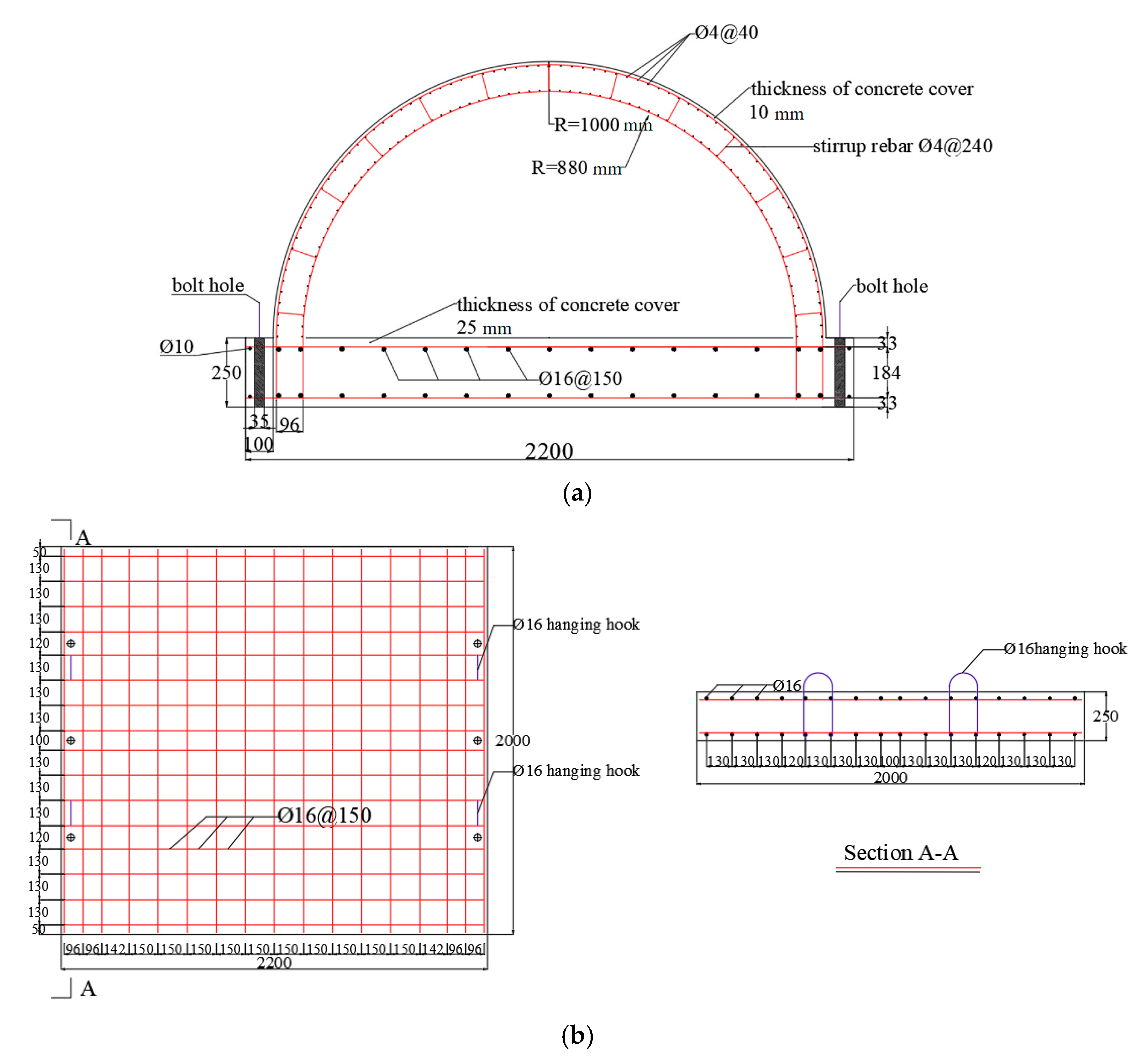




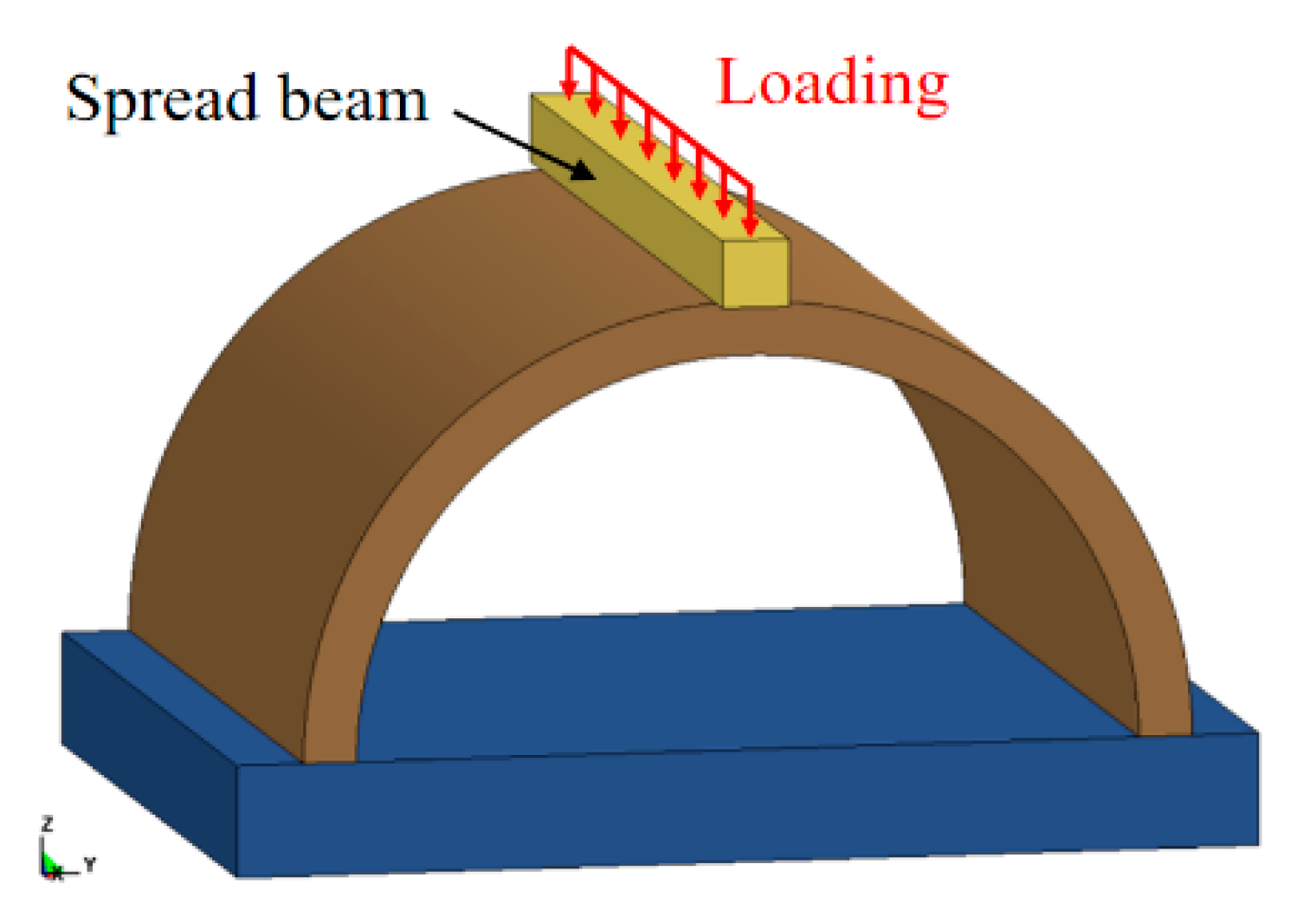
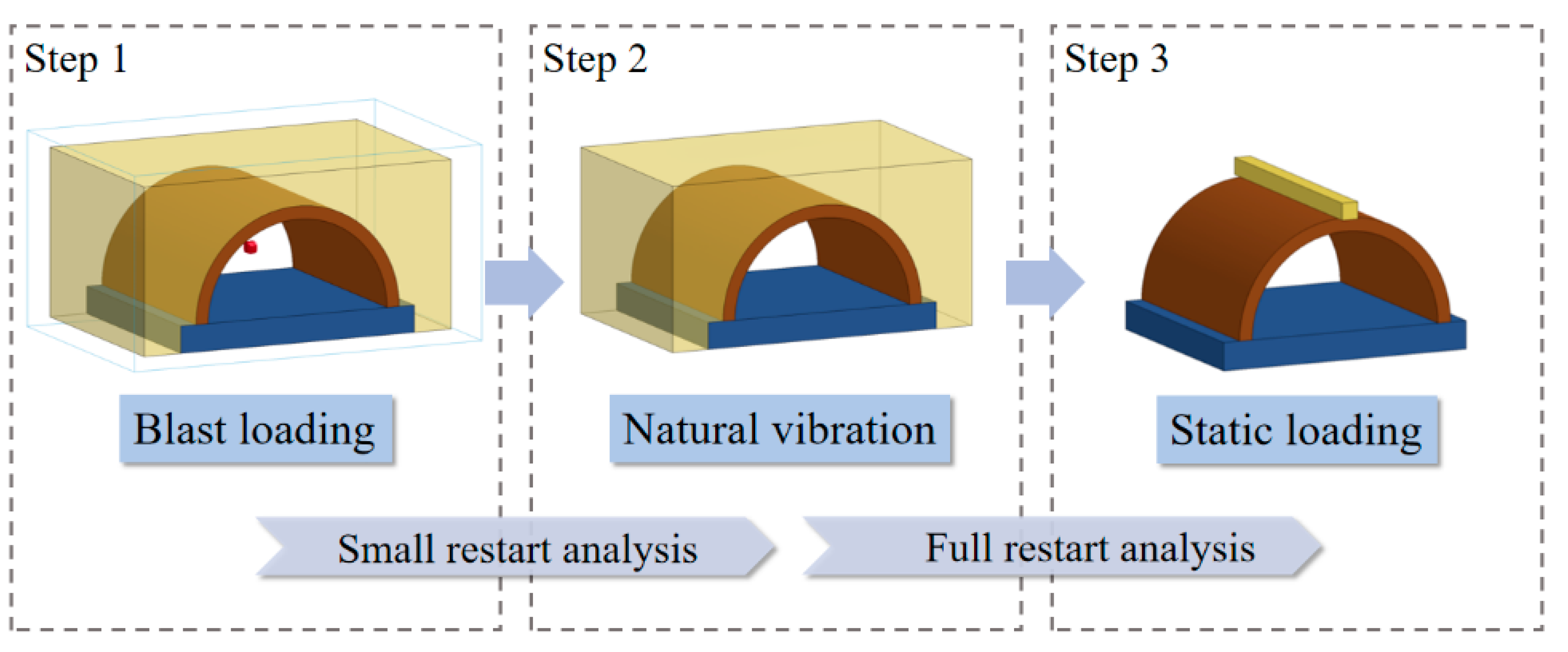



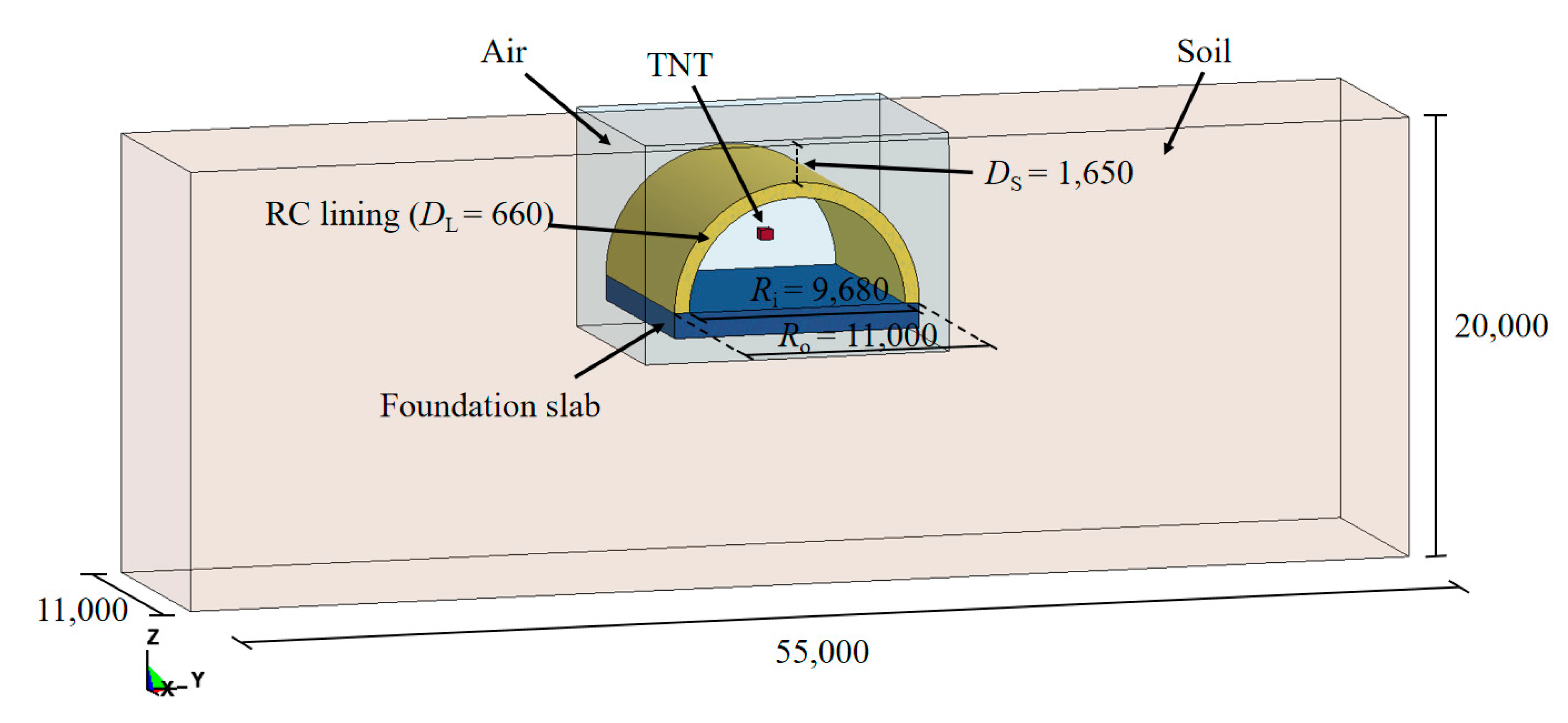


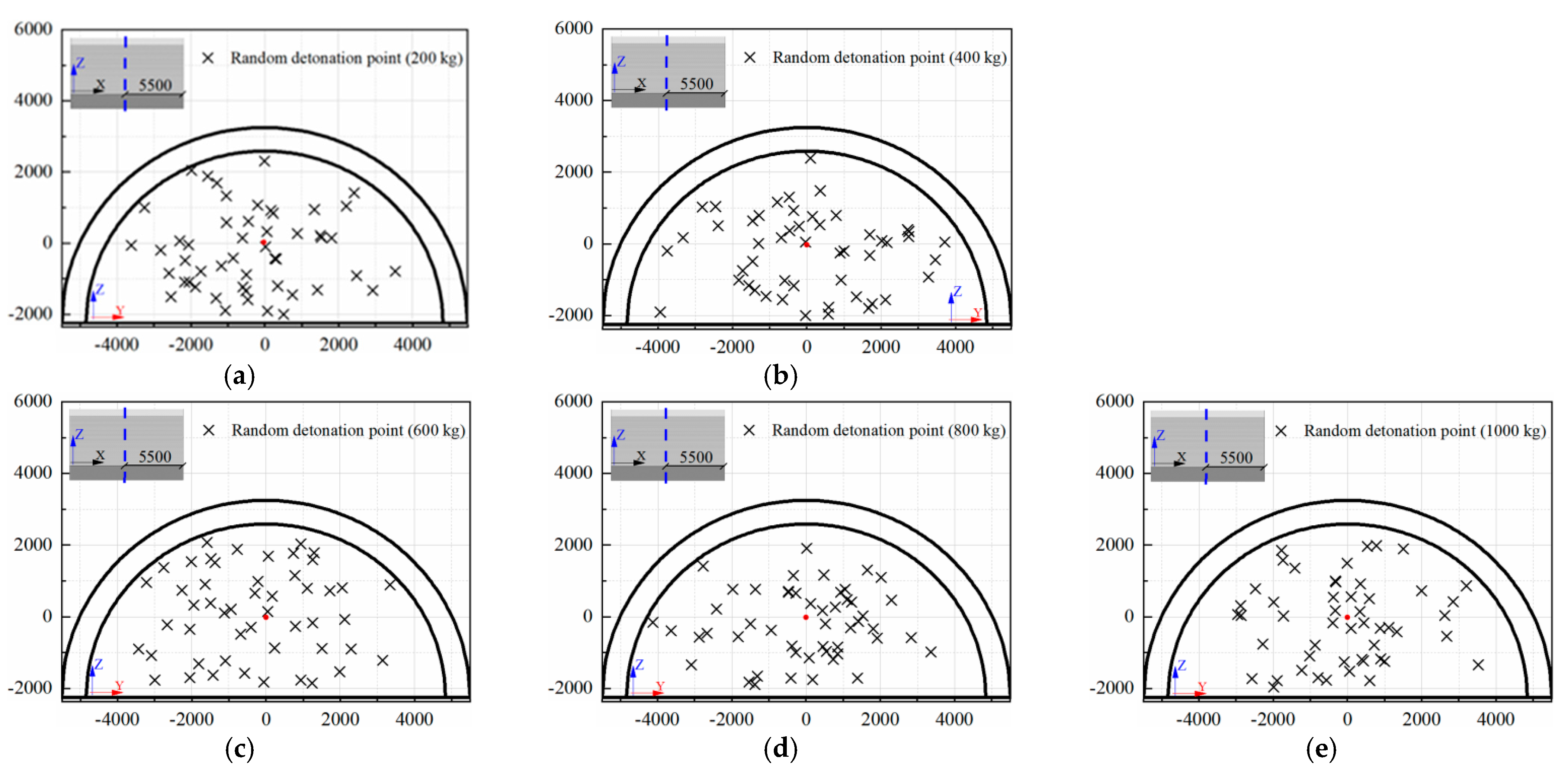



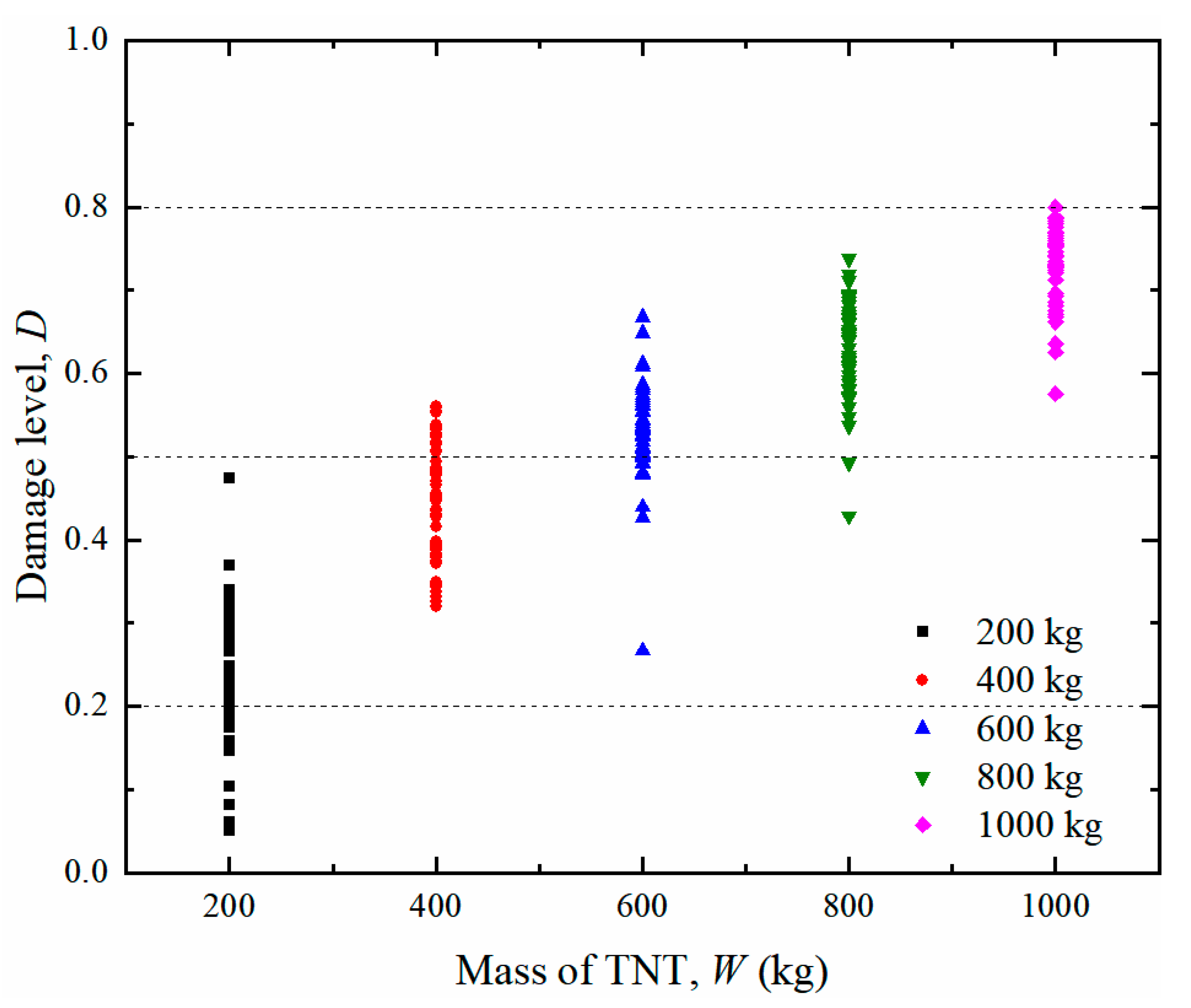
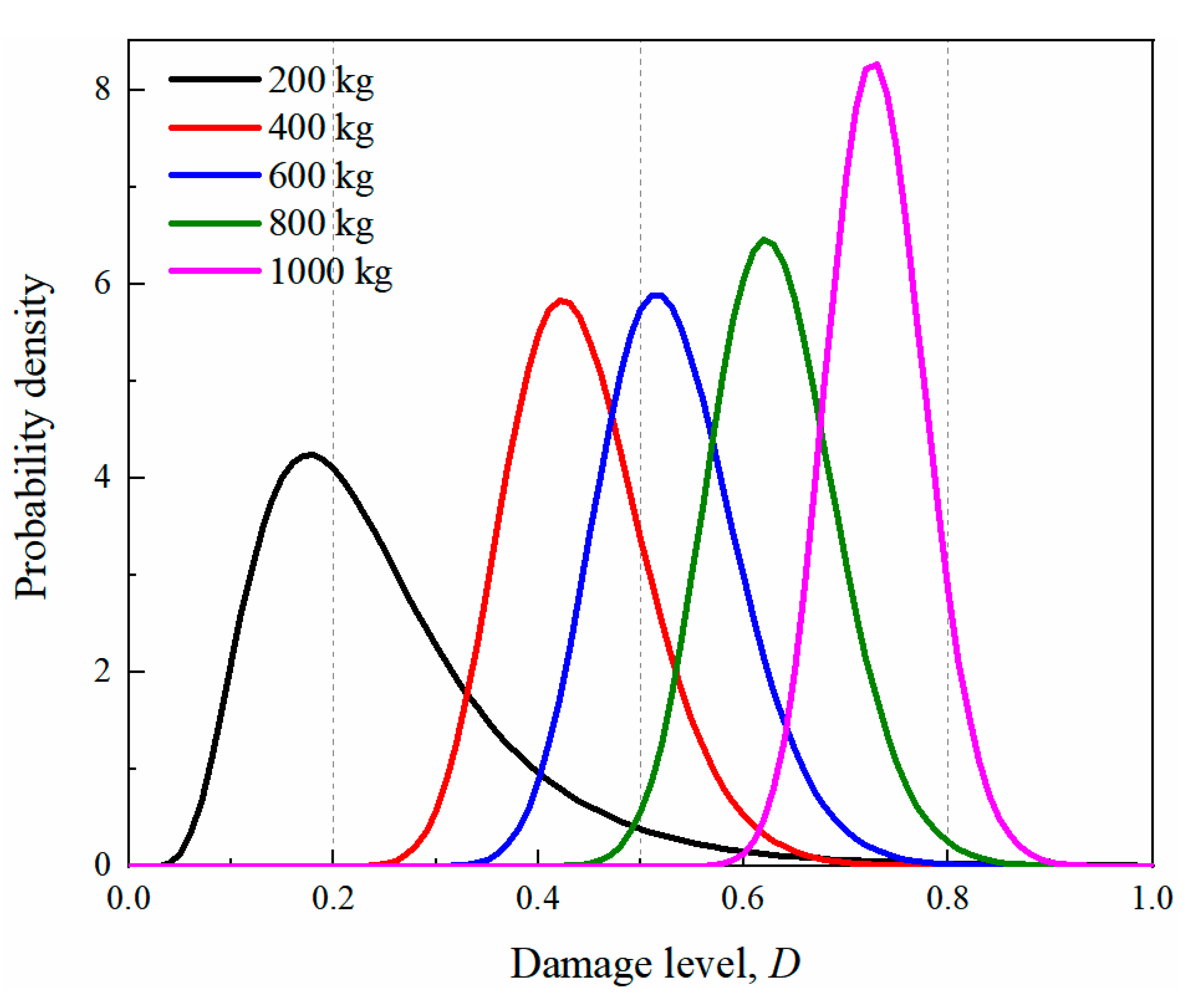
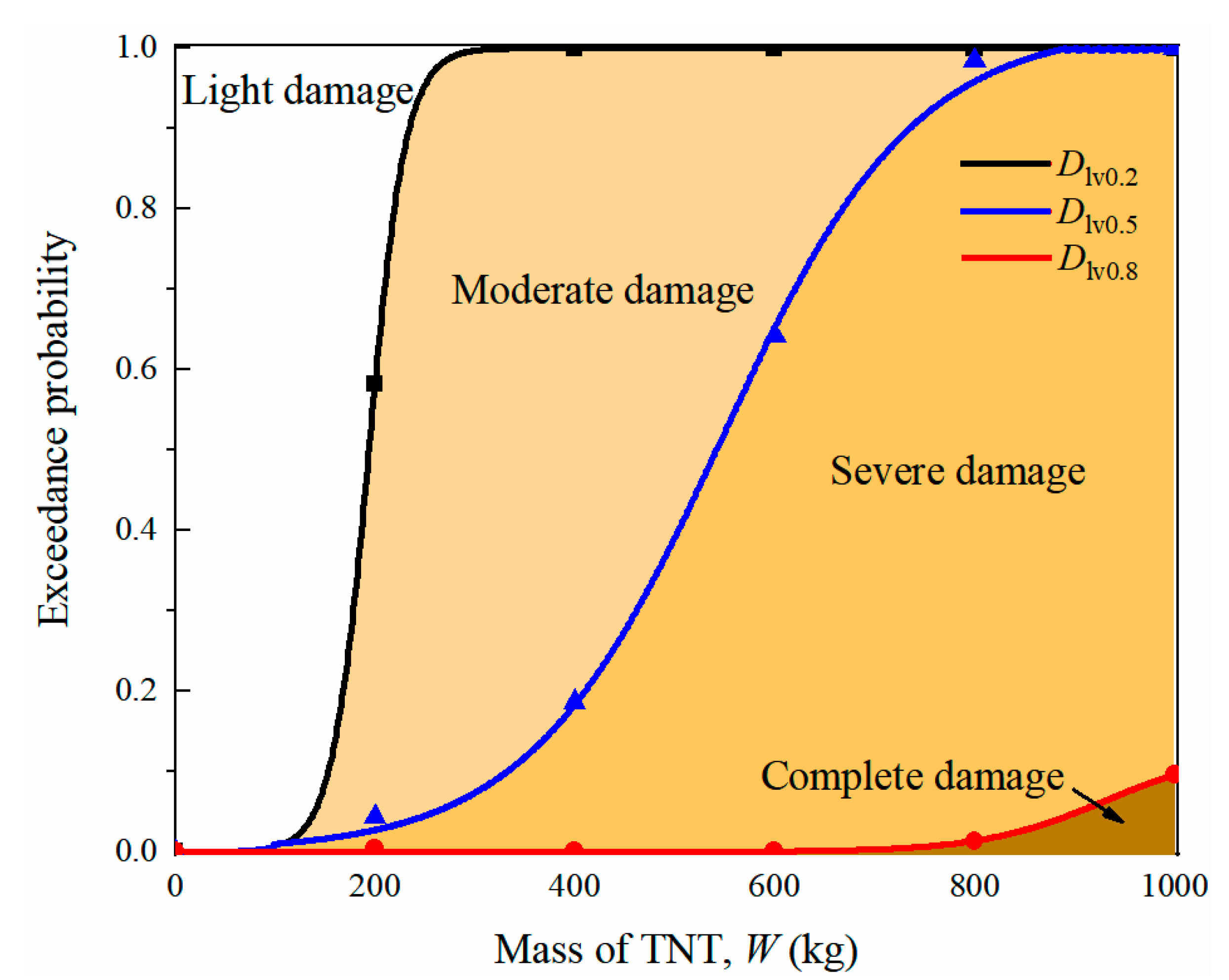
| Quantity | Symbol | Similarity Factor |
|---|---|---|
| Scaling factor | λr | 1/5.5 |
| TNT mass density | λρ | 1 |
| Sound velocity in air | λc | 1 |
| Time | λt = λr/λc | 1/5.5 |
| Blast pressure | λp = λρ λc2 | 1 |
| TNT mass | λM = λp λr λt2 | 1/166.4 |
| Outer radii | λor = λr | 1/5.5 |
| Inner radii | λir = λr | 1/5.5 |
| Lining thickness | λlt = λr | 1/5.5 |
| Reinforcement ratio | λrr | 1 |
| Strength | λfc = λp | 1 |
| Strain | λε | 1 |
| Case | TNT Charge (kg) | Position of Explosion in the Tunnel | Schematic | |
|---|---|---|---|---|
| Cross-Section | Longitude | |||
| B1 | 2 | Center | 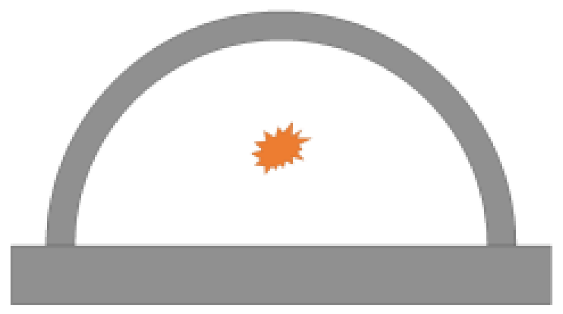 |  |
| B2 | 2 | Top |  | 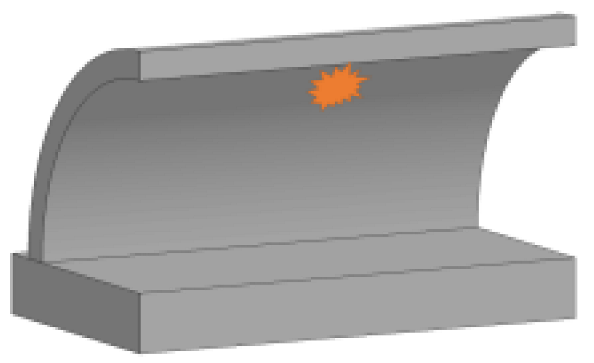 |
| B3 | 2 | Hance |  |  |
| Case | Specimen No. | Position of Explosion |
|---|---|---|
| B0 | Specimen 4 | Intact specimen |
| B1 | Specimen 1 | Center |
| B2 | Specimen 2 | Top |
| B3 | Specimen 3 | Hance |
| Tunnel Lining | Foundation Slab | ||||||
|---|---|---|---|---|---|---|---|
| Parameter | Value | Parameter | Value | Parameter | Value | Parameter | Value |
| fc (MPa) | 24.7 | a1 | 0.4463 | fc (MPa) | 37.4 | a1 | 0.4463 |
| ft (MPa) | 2.551 | a2 | 0.0033 | ft (MPa) | 3.363 | a2 | 0.0022 |
| wc (mm) | 30 | a1f | 0.4417 | wc (mm) | 30 | a1f | 0.4417 |
| h (mm) | 15 | a0y | 5.5130 | h (mm) | 15 | a0y | 8.3480 |
| b1 | 3.13 | a1y | 0.6250 | b1 | 2.73 | a1y | 0.6250 |
| b2 | 1.27 | a2f | 0.0048 | b2 | 1.32 | a2f | 0.0032 |
| a0 | 7.3010 | a2y | 0.0104 | a0 | 11.06 | a2y | 0.0069 |
| Volume Strain (lnV) | 0 | 0.104 | 0.161 | 0.192 | 0.224 | 0.246 | 0.271 | 0.283 | 0.290 | 0.40 |
|---|---|---|---|---|---|---|---|---|---|---|
| Pressure (MPa) | 0 | 8 | 16 | 24 | 48 | 80 | 160 | 240 | 320 | 1640 |
| Density ρ (kg/m3) | Shear Modulus G (MPa) | Bulk Modulus for Unloading K (MPa) | a0 (Pa2) | a2 (Pa) | a3 |
|---|---|---|---|---|---|
| 1820 | 76.01 | 87.87 | 0 | 0 | 0.47 |
| Air | TNT | ||||||
|---|---|---|---|---|---|---|---|
| Parameter | Value | Parameter | Value | Parameter | Value | Parameter | Value |
| ρ (kg/m3) | 1.29 | C4 | 0.4 | ρ (kg/m3) | 1630 | R1 | 4.15 |
| C0 | 0 | C5 | 0.4 | D (m/s) | 6930 | R2 | 0.95 |
| C1 | 0 | C6 | 0 | PCJ (MPa) | 21,000 | ω | 0.3 |
| C2 | 0 | E0 (J/m3) | 0.25 | A (MPa) | 374,000 | E0 (J/m3) | 7 × 109 |
| C3 | 0 | B (MPa) | 3230 | ||||
| Case | Peak Reflected Overpressure (MPa) | ||||||
|---|---|---|---|---|---|---|---|
| B1 | Sensor No. | RP7 | RP8 | RP9 | RP10 | RP11 | RP12 |
| Test | 0.93 | - | - | 1.29 | 1.26 | 0.93 | |
| Simulation | 0.60 | 0.51 | 0.50 | 1.22 | 1.47 | 1.30 | |
| Deviation (%) | −35.5 | - | - | −5.4 | 16.7 | 39.8 | |
| B2 | Sensor No. | - | - | - | RP4 | RP5 | RP6 |
| Test | - | - | - | 2.75 | 2.61 | 2.40 | |
| Simulation | - | - | - | 2.56 | 2.25 | 1.55 | |
| Deviation (%) | - | - | - | −6.9 | −13.8 | −35.4 | |
| B3 | Sensor No. | RP7 | RP8 | RP9 | RP10 | RP11 | RP12 |
| Test | 0.84 | 1.03 | 0.68 | 1.58 | 1.46 | 0.57 | |
| Simulation | 1.65 | 1.09 | 0.83 | 1.69 | 0.97 | 0.33 | |
| Deviation (%) | 96.4 | 5.8 | 22.1 | 7.0 | −33.6 | −42.1 | |
| Case | Test | Simulation | Average Deviation | ||||||
|---|---|---|---|---|---|---|---|---|---|
| Inner Face | Outer Face | Inner Face | Outer Face | ||||||
| d1 | d2 | d1 | d2 | d1 | d2 | d1 | d2 | ||
| B2 | 500 | 560 | 530 | 580 | 540 | 600 | 580 | 610 | 7.44% |
| B3 | 500 | 400 | 600 | 660 | 550 | 448 | 630 | 710 | 8.64% |
| Case | Specimen No. | Bearing Capacity (kN) | Deviation | |
|---|---|---|---|---|
| Test | Simulation | |||
| B0 | Specimen 5 | 600.00 | 585.00 | 2.5% |
| B1 | Specimen 2 | 531.64 | 510.69 | 3.9% |
| B2 | Specimen 3 | 454.21 | 411.52 | 9.3% |
| B3 | Specimen 4 | 573.39 | 507.00 | 11.5% |
| Potential Explosion Threats |  |  |  |  |  |
|---|---|---|---|---|---|
| Suitcase | Compact Sedan | Sedan | Cargo Van | Delivery Truck | |
| TNT equivalent (kg) | 23 | 227 | 454 | 1814 | 4536 |
| Residual Bearing Capacity (kN) | |||
|---|---|---|---|
| Position of the Detonation Point | Center | Tunnel Crown | Tunnel Hance |
| W = 23 kg | 4598 | 4370 | 4452 |
| W = 227 kg | 3858 | 2540 | 3671 |
| W = 454 kg | 2954 | 2005 | 2413 |
| W = 1814 kg | 330 | 254 | 631 |
| W = 4536 kg | 42.4 | 20.1 | 41.8 |
| D | Damage Levels |
|---|---|
| 0–0.2 | Light damage |
| 0.2–0.5 | Moderate damage |
| 0.5–0.8 | Severe damage |
| 0.8–1 | Complete damage |
| M/kg | Lognormal Mean (µln) | Lognormal Standard Deviation (σln) |
|---|---|---|
| 200 | −1.510 | 0.477 |
| 400 | −0.835 | 0.160 |
| 600 | −0.646 | 0.130 |
| 800 | −0.466 | 0.099 |
| 1000 | −0.315 | 0.066 |
Publisher’s Note: MDPI stays neutral with regard to jurisdictional claims in published maps and institutional affiliations. |
© 2022 by the authors. Licensee MDPI, Basel, Switzerland. This article is an open access article distributed under the terms and conditions of the Creative Commons Attribution (CC BY) license (https://creativecommons.org/licenses/by/4.0/).
Share and Cite
Liu, Z.; Wu, J.; Chen, Q.; Li, S.; Yan, Q.; Yu, H. Analysis on the Vulnerability of a Tunnel Entrance under Internal Explosion. Sensors 2022, 22, 9727. https://doi.org/10.3390/s22249727
Liu Z, Wu J, Chen Q, Li S, Yan Q, Yu H. Analysis on the Vulnerability of a Tunnel Entrance under Internal Explosion. Sensors. 2022; 22(24):9727. https://doi.org/10.3390/s22249727
Chicago/Turabian StyleLiu, Zichao, Jun Wu, Qinyi Chen, Shutao Li, Qiushi Yan, and Haitao Yu. 2022. "Analysis on the Vulnerability of a Tunnel Entrance under Internal Explosion" Sensors 22, no. 24: 9727. https://doi.org/10.3390/s22249727
APA StyleLiu, Z., Wu, J., Chen, Q., Li, S., Yan, Q., & Yu, H. (2022). Analysis on the Vulnerability of a Tunnel Entrance under Internal Explosion. Sensors, 22(24), 9727. https://doi.org/10.3390/s22249727







